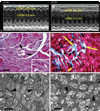A mouse model of mitochondrial disease reveals germline selection against severe mtDNA mutations
- PMID: 18276892
- PMCID: PMC3049809
- DOI: 10.1126/science.1147786
A mouse model of mitochondrial disease reveals germline selection against severe mtDNA mutations
Abstract
The majority of mitochondrial DNA (mtDNA) mutations that cause human disease are mild to moderately deleterious, yet many random mtDNA mutations would be expected to be severe. To determine the fate of the more severe mtDNA mutations, we introduced mtDNAs containing two mutations that affect oxidative phosphorylation into the female mouse germ line. The severe ND6 mutation was selectively eliminated during oogenesis within four generations, whereas the milder COI mutation was retained throughout multiple generations even though the offspring consistently developed mitochondrial myopathy and cardiomyopathy. Thus, severe mtDNA mutations appear to be selectively eliminated from the female germ line, thereby minimizing their impact on population fitness.
Figures




Comment in
-
Medicine. Sidestepping mutational meltdown.Science. 2008 Feb 15;319(5865):914-5. doi: 10.1126/science.1154515. Science. 2008. PMID: 18276880 No abstract available.
References
-
- Wallace DC, Lott MT, Procaccio V. In: Emery and Rimoin’s Principles and Practice of Medical Genetics. ed. 5. Rimoin DL, Connor JM, Pyeritz RE, Korf BR, editors. vol. 1. Philadelphia: Churchill Livingstone; 2007. pp. 194–298.
-
- Schaefer AM, Taylor RW, Turnbull DM, Chinnery PF. Biochim. Biophys. Acta. 2004;1659:115. - PubMed
-
- Schaefer AM, et al. Ann. Neurol. 2007 10.1002/ana.21217.
Publication types
MeSH terms
Substances
Grants and funding
LinkOut - more resources
Full Text Sources
Other Literature Sources
Molecular Biology Databases

